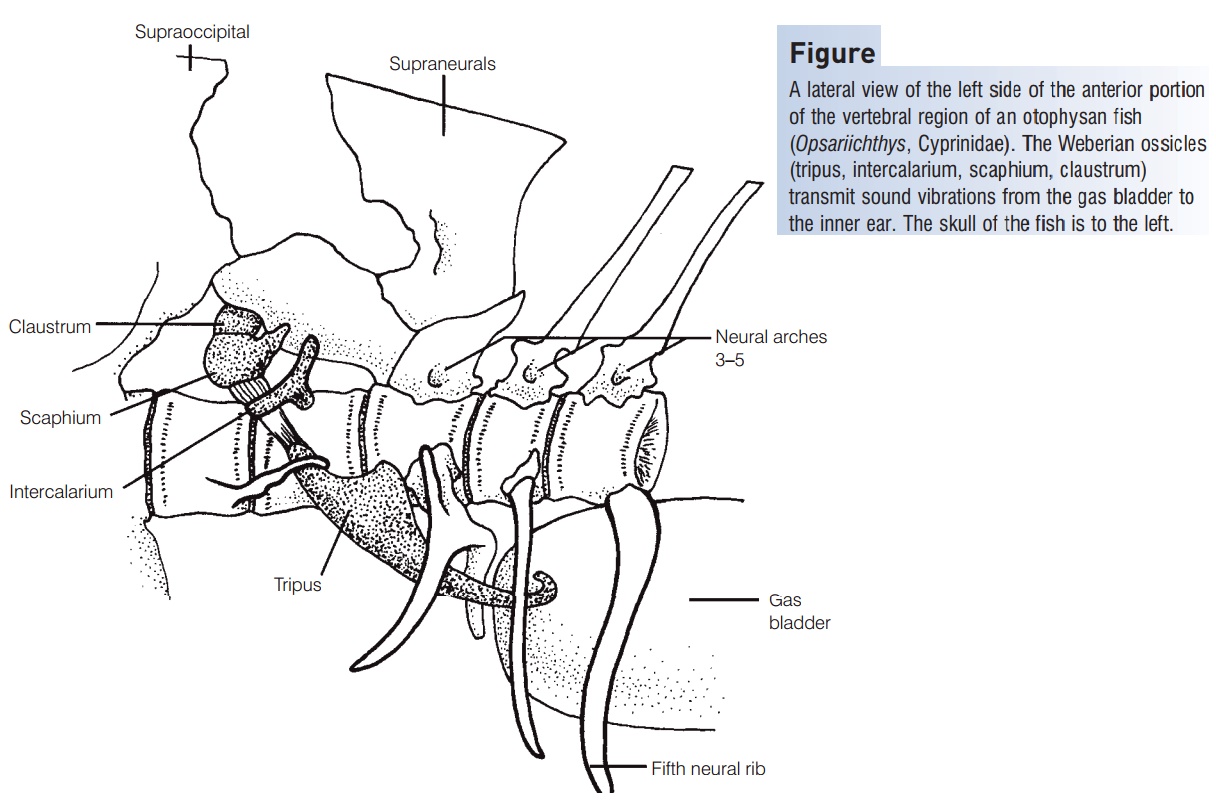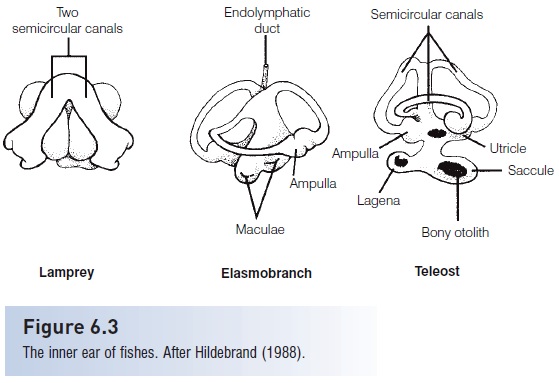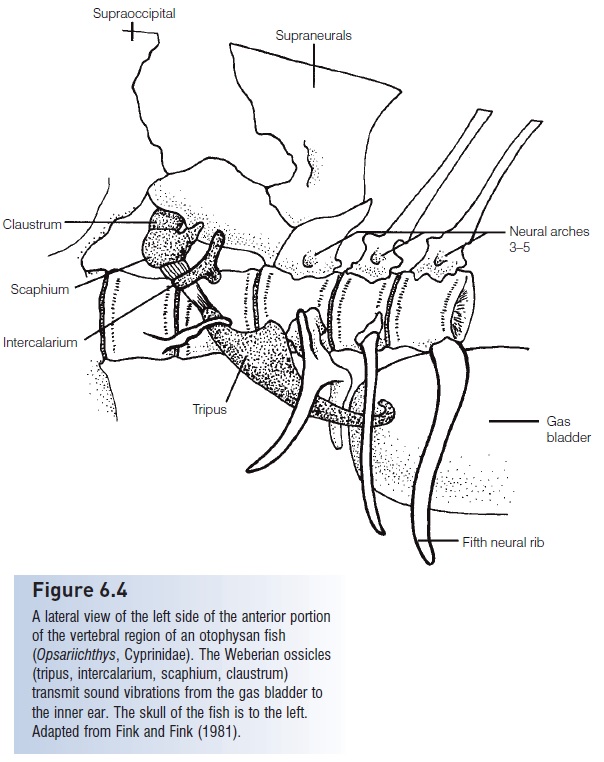Chapter: The Diversity of Fishes: Biology, Evolution, and Ecology: Sensory systems
Hearing in fishes

Hearing
Hearing in fishes is primarily the responsibility of the inner ear, including the utricle of the pars superior and the sacculeandlagenaof the pars inferior (see Fig. 6.3). Each chamber contains an otolith (the lapillus, sagitta and astericus,respectively) and is lined with patches of tissue composed of sensory hair cells. An otolithic membrane provides a mechanical linkage between the otolith and the cilia of the sensory hair cells.

Most fish tissue is transparent to sound because its density is similar to that of the water. Structures that are significantly different in density, however, will vibrate differently from the rest of the fish’s tissues and provide an opportunity for sensory detection of sound. As sound vibrations pass through a fish, the otoliths lag behind in their vibration due to their greater density. The relative difference in vibration between the fish’s sensory hair cells and the otoliths excites the sensory hair cells and triggers action potentials in the sensory neurons of the auditory nerve(Schell art& Wubbels 1998).
Aquatic environments are quite varied in the levels of background sound, and not surprisingly hearing sensitivity of fishes is well matched to their habitats. Fishes in noisy habitats, such as coastlines and swift rivers and streams, tend to have higher sound thresholds and narrower ranges for sound detection than fishes in calmer, quieter habitats such as small lakes and ponds with soft substrate bottoms(Schell art& Wubbels 1998). Sound waves may cause gas spaces in a fish, such as a gas bladder, to vibrate, thereby providing an opportunity to enhance sound detection. Fishes that are hearing specialists have mechanisms that transmit gas bladder vibrations to the inner ear for detection by the otolith organs, whereas fishes without such a connection, or that lack a gas bladder, are not as sensitive to sound and are referred to as hearing generalists (Yan2003). Hearing specialists include the cods (Gadidae),which have a gas bladder close to the inner ear, and squirrelfish (Holocentridae) and herring and sardines (Clupeidae)in which anterior extensions from the gas bladder contact the inner ear (Akamatsu et al. 2003). Africanmormyrids (Mormyridae), also known for sensitive hearing, have separate otic gas bladders adjacent to the inner ear that assist with sound detection (Yan &Curt singer 2000).And the saccule of the inner ear of gourami’s (Anabantoidei)protrudes into the upper part of the air-filled suprabranchialchamber (used for air breathing), thereby significantly enhancing the fishes’ hearing sensitivity (Yan 1998).
The largest group of hearing specialists is the otophysanfishes, which dominate the fresh waters of the world (over60% of all freshwater species). They have particularly acute hearing and pitch discrimination due to the Weberian ossicles,a series of small bones derived from modified vertebrae that connect the anterior end of the gas bladder to the inner ear (Fig. 6.4).

Figure 6.4
A lateral view of the left side of the anterior portion of the vertebral region of an otophysan fish(Opsariichthys, Cyprinidae). The Weberian ossicles(tripus, intercalarium, scaphium, claustrum)transmit sound vibrations from the gas bladder to the inner ear. The skull of the fish is to the left. Adapted from Fink and Fink (1981).
These conduct sound vibrations in much the same manner as the middle ear ossicles of mammals. Because of the Weberian ossicles and gas bladder, the otophysans have the highest sensitivity and greatest frequency range of hearing among fishes. Interference with the Weberian ossicles of the otophysans, or deflation of the gas bladder of any of the hearing specialist fishes, results in decreased hearing sensitivity (Yan et al. 2000).
Much less is known about hearing in elasmobranchs than in bony fishes. The basic structure of elasmobranch inner ears is very similar to that of bony fishes, except that sharks have a connection from a depression in the back of their skulls to ducts in the semicircular canals that contain the sensory area (Hueter et al. 2004). This connection,called the fenstra ovalis, is presumed to enhance hearing by directing sound to the sensory area (macula neglecta) of the inner ear. Shark hearing is most sensitive at low frequencies, including those below 10 Hz, which are undetectable by humans, but they may be no more sensitive than many other fishes that are hearing generalists. Sharks are most sensitive to pulsed sounds in this range, such as those emitted by the erratic swimming of an injured fish, and can localize such sounds at distances of up to 250 m (Myrberg1978; Myrberg & Nelson 1991; Subclass Elasmobranchii, Sensory physiology).
Sources of underwater sound
Apparently, natural selection pressures have driven the evolution of various adaptations to enhance hearing among fishes. So it must be important for some fishes to hear well– but what do they hear that could be so important? OneSource of sounds is predators. Cetaceans, such as dolphins, emit sounds and use echolocation for orientation and to locate prey. Although most marine fishes studied thus far cannot detect sound frequencies above about 500 Hz,at least some clupeids can detect considerably higher frequencies. The ability of some clupeids to detect ultrasound has been attributed to the anterior extensions of the gas bladder that is characteristic of the group. However, not all clupeids can detect ultrasound, and Higgs et al. (2004)believe that modifications of the utricle seen in those clupeids that can detect ultrasound is responsible for thisability. The American Shad (Alosa sapidissima), Alewife(A. pseudoharengus), and Pacific Herring (Clupea pallasii)can detect ultrasonic signals (up to 180 kHz in American Shad), and may use this ability to avoid predatory cetaceans trying to locate them using ultrasound (Plachta &Popper 2003). Another clupeid, the Spot linedSardine(Sardinops melanostictus), can detect sounds of 1 kHz(Akamatsu et al. 2003).
Another source of underwater sounds are fishes themselves– many of which create sounds for inter- and intraspecific communication. Fishes can produce sounds using several different mechanisms. Some catfishes (Siluriformes),toadfishes (Batrachoididae), cods (Gadidae), and sea robins(Triglidae) use muscles to create sound from the gas bladder(see Ladich & Yan 1998). Some catfishes rub together bones of the pectoral girdle, whereas some cichlids and gouramis(Anabantoidei) create sound by grinding together their pharyngeal teeth. The croaking gouramis (Trichopsis) create pulsed sounds by strumming tendons over elevations of fin rays by rapidly beating their pectoral fins. The close proximity of the anabantoid sonic organs to the suprabranchial chamber, which is used for air breathing, suggests that this air-filled chamber may enhance the resonance of the sound produced. The close relationship between the frequencies of vocalization and maximum hearing sensitivity also suggests that these features coevolved (Ladich & Yan 1998).
Fishes detect ambient sounds from their environment, and alter their behavior accordingly. Biological sound, suchas that produced by other fishes and invertebrates, attracts larval reef fishes to preferentially settle in areas with sounds that would indicate a suitable habitat (Montgomery et al.2001b). Ambient noise may also impact the evolution of hearing and sound production for communication. Males of two species of freshwater gobies (Gobiidae) that inhabit swift, rocky streams respond to and produce courtship sounds at frequencies within a “quiet window” of ambientnoise around 100 Hz (Lugli et al. 2003). The hearing of these fishes is most sensitive within this range, suggesting that ambient sound may be a selective force in the evolution of hearing and noise production.
The sensitivity of fishes, especially hearing specialists, to sound makes them potentially vulnerable to humangenerated underwater noise. McCauley et al. (2003) showed that high-intensity, low-frequency sound produced by airguns used in marine petroleum exploration can cause severe damage to the hair cells of fish inner epithelia. And even less intense sound can result in loss of hearing sensitivity in the otophysan Fathead Minnow (Pimephales notatus),although the less sensitive hearing generalist Bluegill(Lepomis macrochirus) was not significantly affected(Scholik & Yan 2002). Prolonged exposure of Goldfish(Carrasius auratus) to loud sound resulted in hearing loss in this otophysan species (Smith et al. 2004).
Related Topics